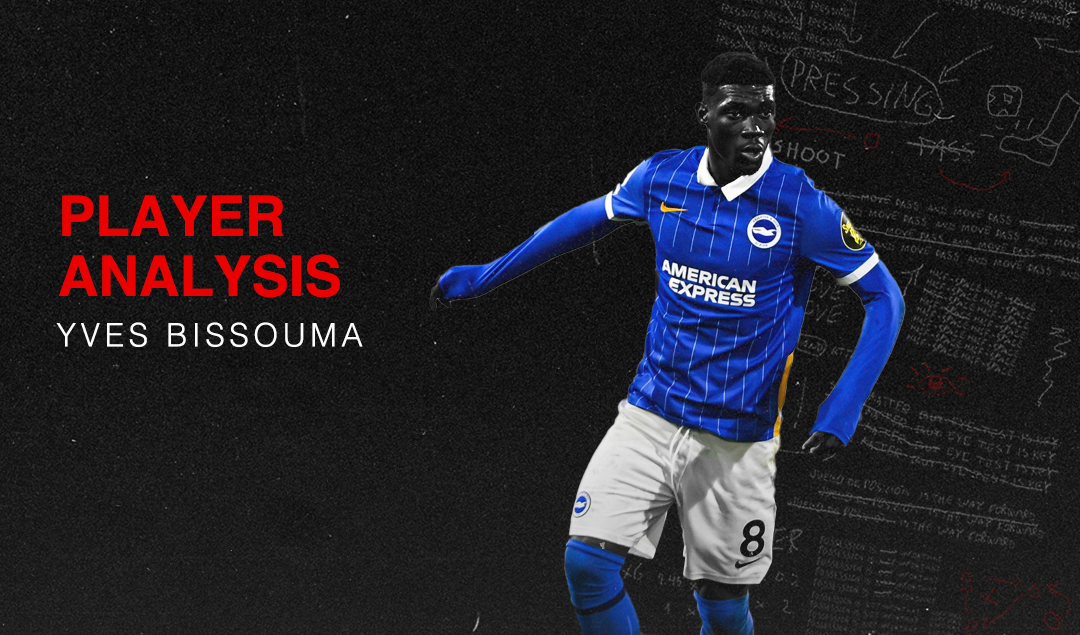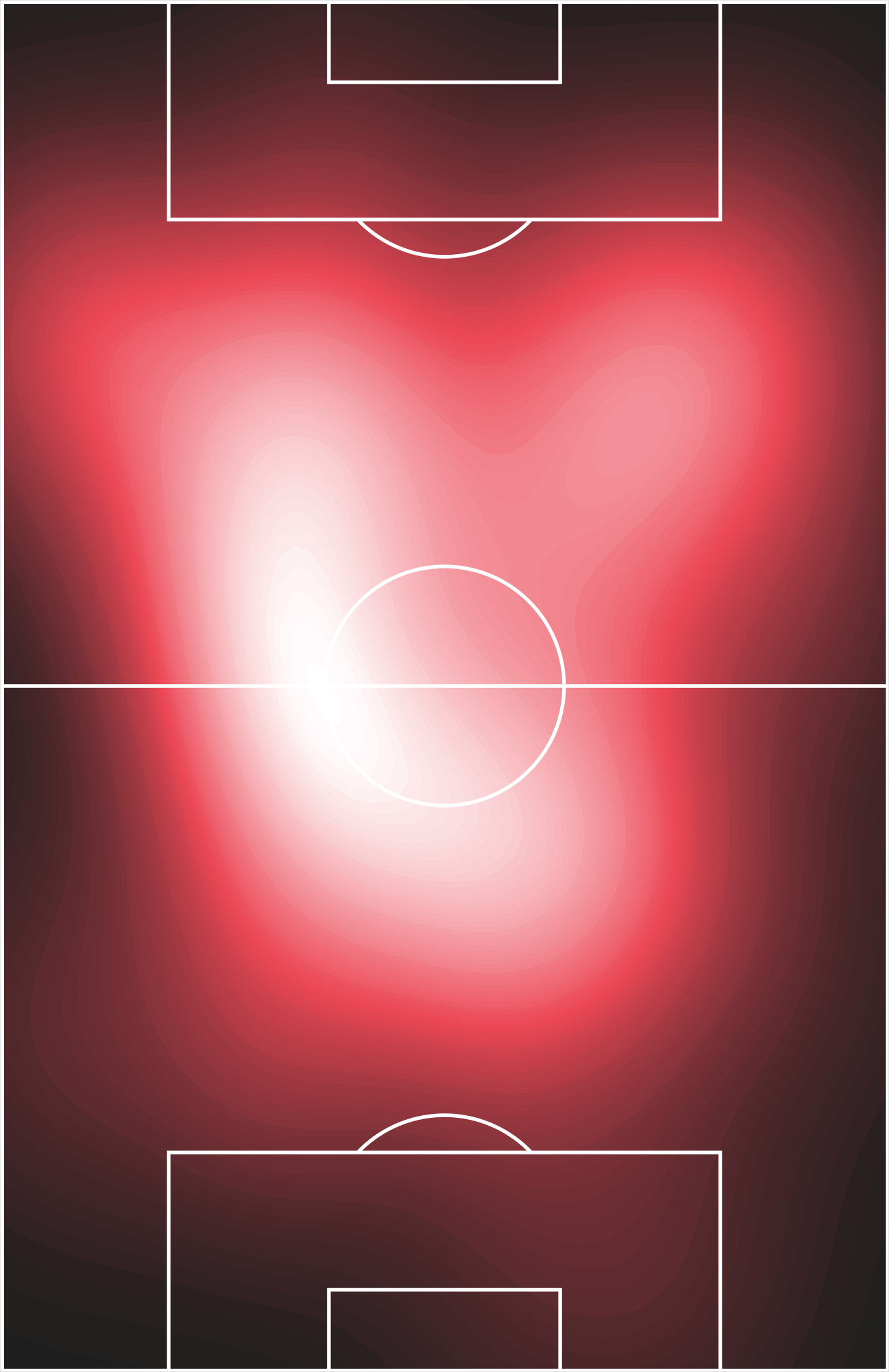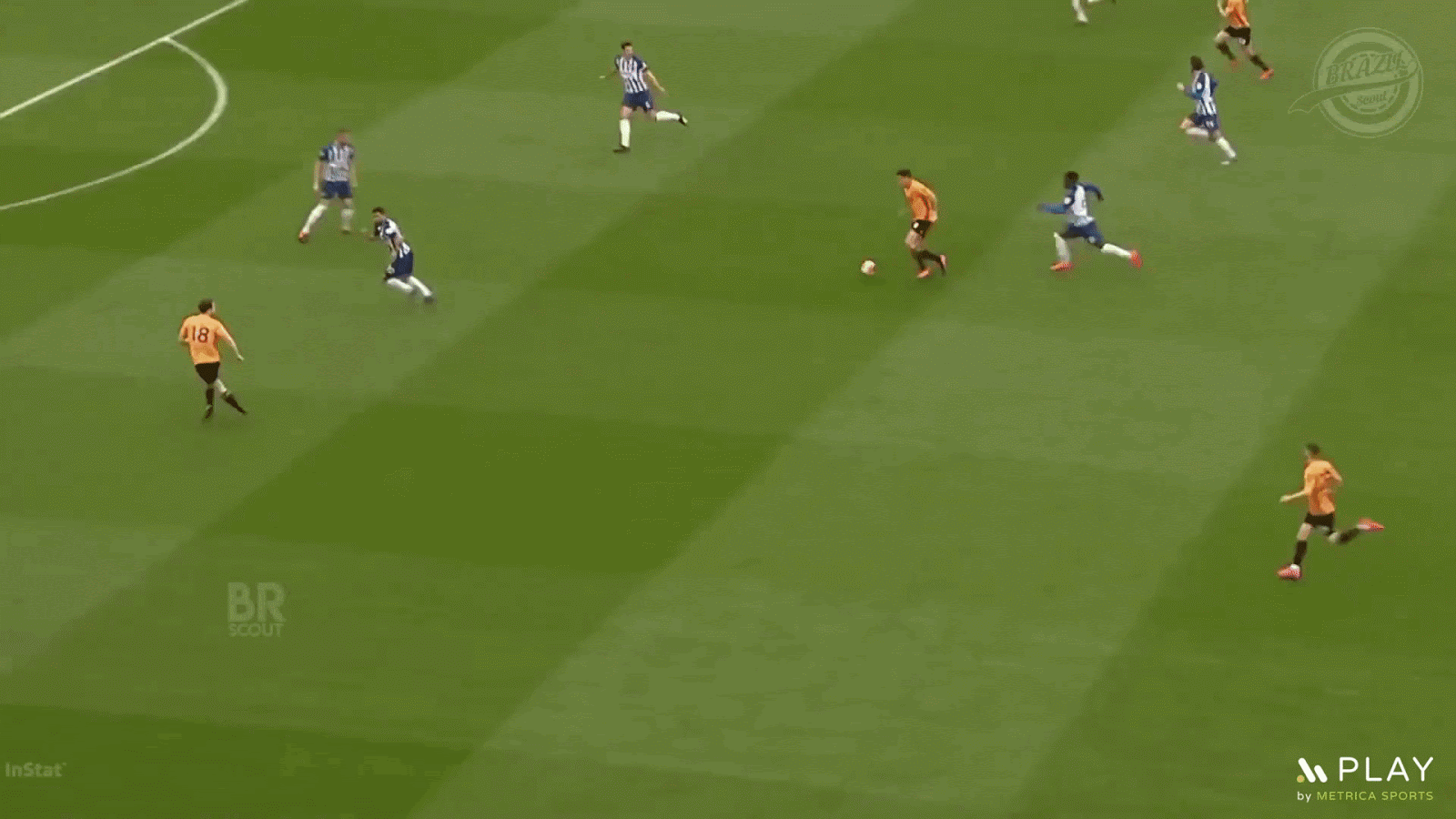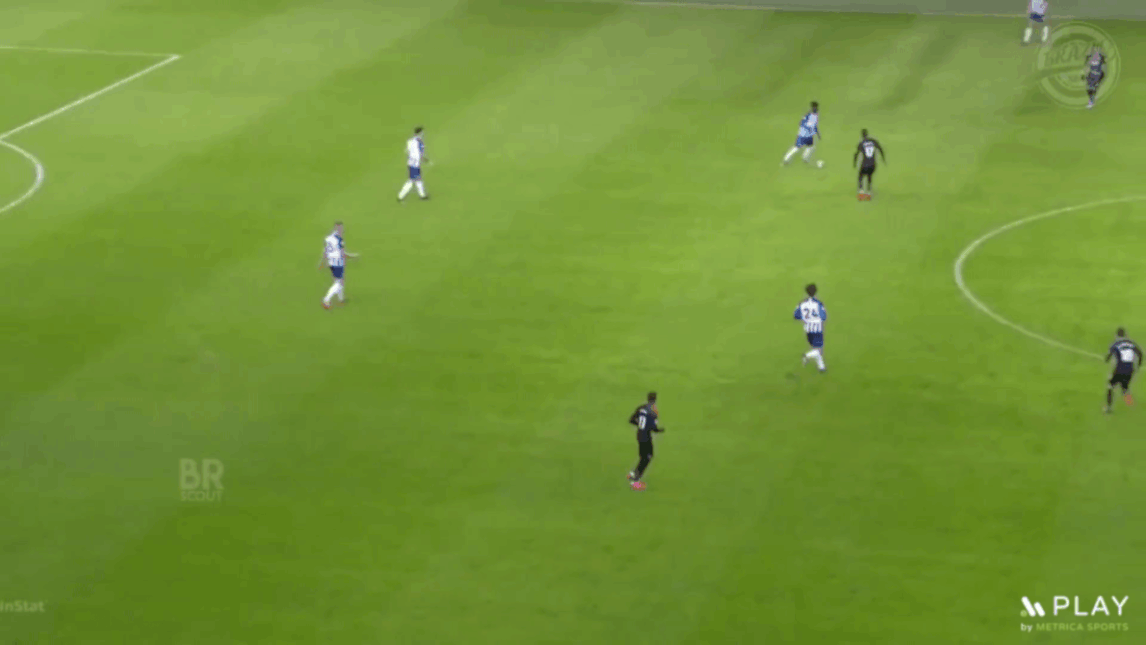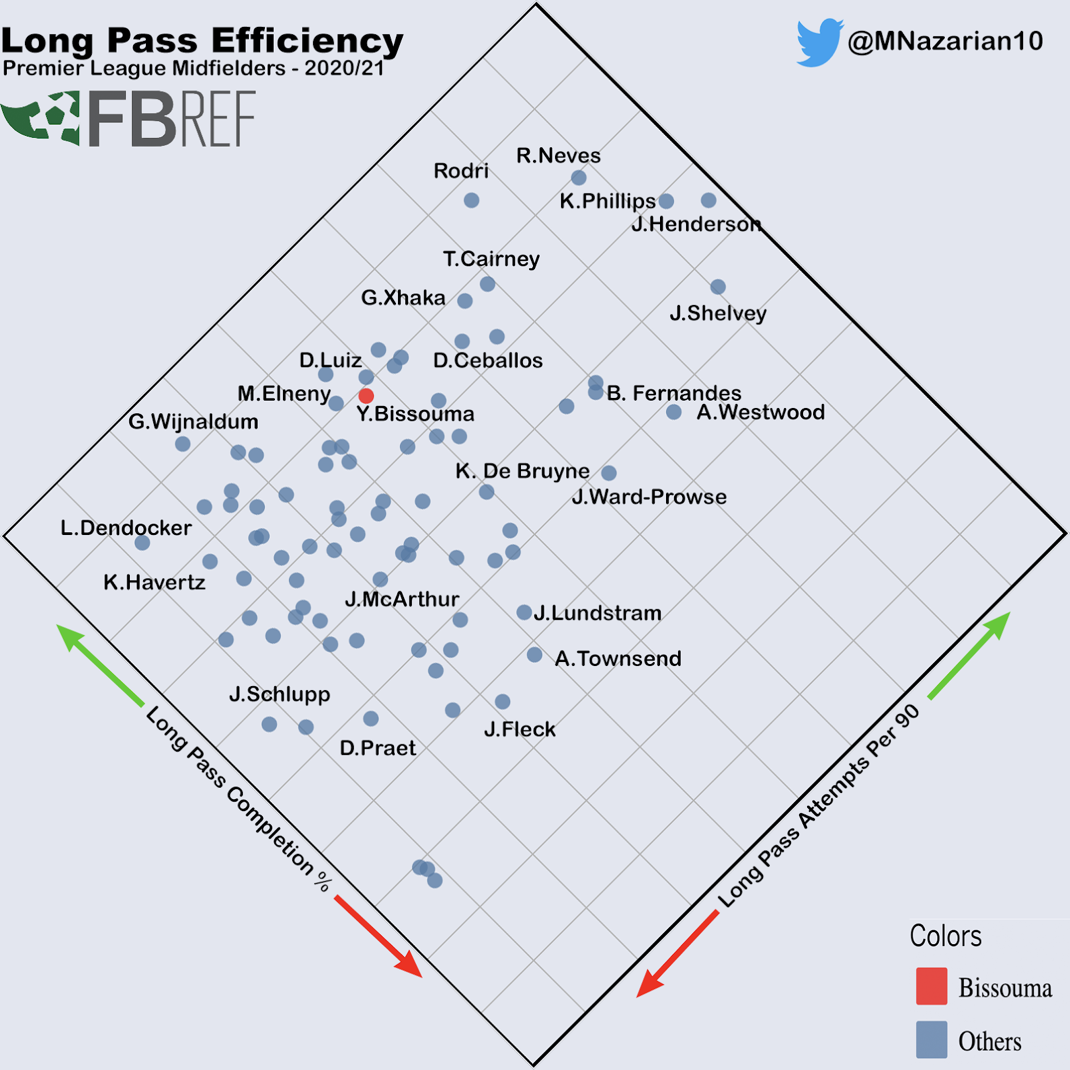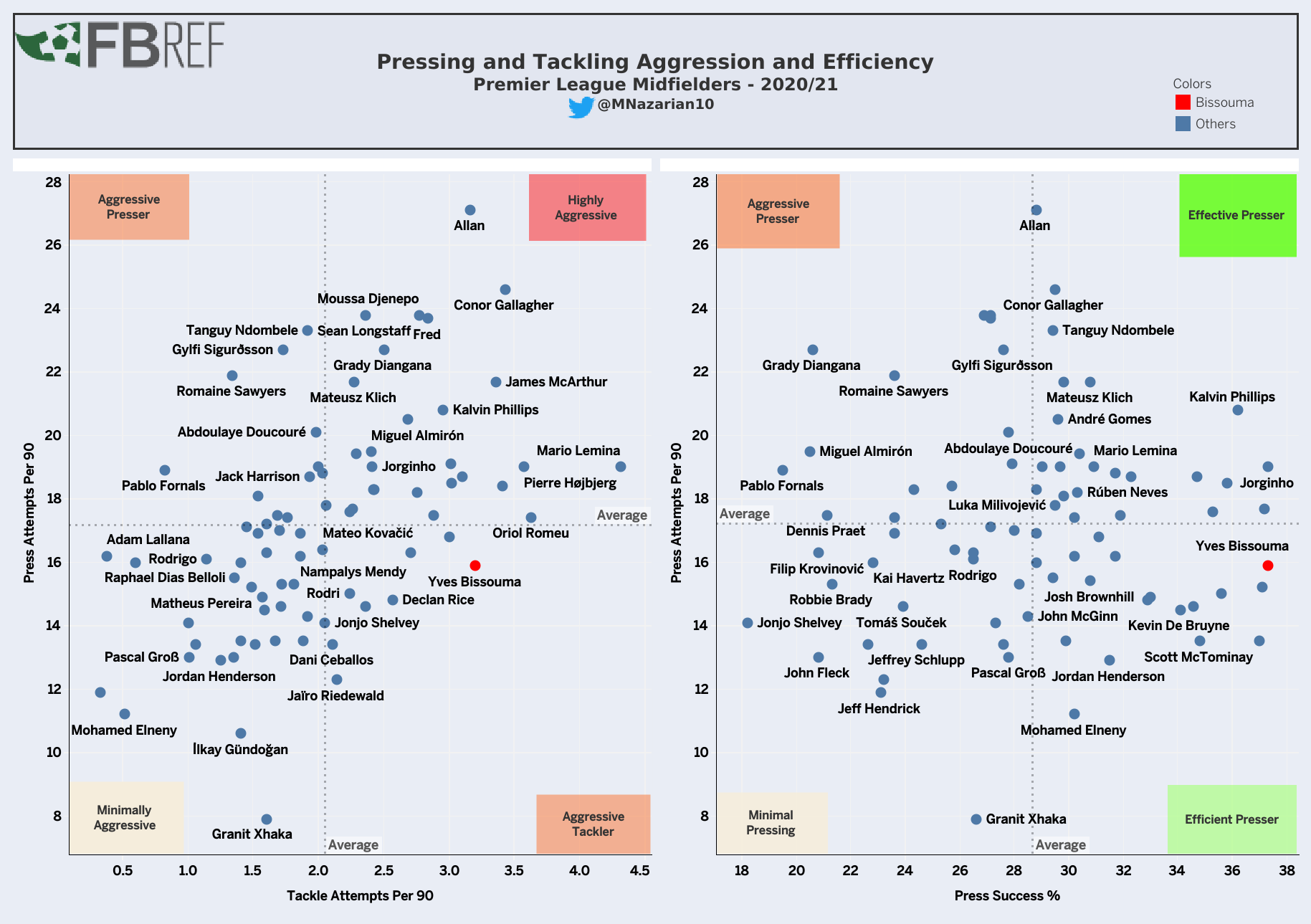Player Analysis: Yves Bissouma
Since taking over from Chris Hughton in the summer of 2019, Graham Potter’s Brighton Hove & Albion side have been a unique watch, to say the least. On the surface, one could conclude that they have continued their theme of struggles in which they sit just outside the relegation zone. In the past 3 years since promotion to the Premier League, Brighton have not exceeded a 15th place finish and have not finished clear of the drop by more than 7 points.
However, this year is different. Briefly glancing on some metrics show us the team has significantly improved both in the offensive and defensive phase, however, their results are not indicative of this. Since Potter’s appointment, Brighton have begun playing much more possession-based and direct in a 3-4-3/3-4-2-1 in contrast to the low block system Hughton employed.
In contrast to last year, Potter’s side have significantly improved in both xG per 90 and xGA per 90 meaning they are creating better chances more often in games, and simultaneously limiting the opportunities opponents have created against them. In 2019, their xG differential per 90 was -0.35, while this year it’s 0.42, only behind Liverpool, City, Chelsea, and Aston Villa.
Although Brighton’s results are marginally different than previous years, the underlying metrics show significant improvement in Potter’s side and this has translated to getting the best out of many players in the Sussex team. Tariq Lamptey, Ben White, and Solly March are just some of the standout players who have done well this season. However, at the heart of the team is Yves Bissouma who may be the most impressive of them all.
Yves Bissouma joined his first club, AS Real Bamako, in 2014 in his native country of Mali. He made his move to Lille in 2016 where he signed his first professional contract playing primarily as a midfielder, and just 2 years later in 2018 was acquired by Brighton for a fee of $18.60 million. In his past 2 seasons at Brighton, Bissouma has been an important player for the squad playing 28 games in his first campaign and 22 in his second.
However, as time has passed, he’s become increasingly important for the team and this year more than ever, it seems what was raw talent and glimpses of ability has found tactical discipline and consistency in focus which has added significant value to this Brighton side. Although Bissouma is not necessarily a goal contributing player, he is almost everything else; an extremely well-rounded player with a high level of technique that covers a lot of ground quickly.
We’ll be analyzing Yves Bissouma in order to gain a better understanding of what makes him such a unique player, and what he does in-game that adds value to Brighton. The analysis will include a look at what kind of player he is, his position and role in-game, his in-game tendencies and skills, and which metrics stand out in his game for Brighton.
Position and Role
Yves Bissouma is a central midfielder who is usually played alongside Steven Alzate, the more defensive player of the two, with two wing-backs on either side of the midfield for width. Bissouma generally plays on the right side of the formation as shown below in the most used 11.
Photo: Twenty3/Wyscout
When playing alongside a more defensive partner, Bissouma is allowed much more freedom to roam and display his talents in different parts of the pitch while still having a defensive anchor behind him. He plays as a No.8, but very much possesses box-to-box abilities and has even been deployed as a defensive mid in a double pivot on occasion.
In the 3-4-3/3-4-2-1, as a result of being a part of a midfield pairing, he covers a lot of ground in the central areas. He has an engine and work rate which allows him to cover ground very quickly and is heavily utilized in both attack and defense.
In possession, the Malian is tasked with dropping deep and assisting in the build-up, and in defense he is often used to break up play as he is able to recover quite well and tackle aggressively. Both phases of play will be discussed in further detail throughout the different sections of the analysis. The heat map below from Brighton’s game against Crystal Palace accurately represents Bissouma’s role and engine in Potter’s system.
Photo: Twenty3/Wyscout
With 77 touches, we can see Bissouma had significant involvement in the game and additionally we notice this involvement was in multiple different areas of the field. Although this game Bissouma started on the left in the center where most of his actions were, we see he had many involvements on the right-center, as well as on both sides of the field on the attack. We can also see that he often tends to not push further up into the box often.
As we can see from his positioning he is used in a multitude of areas, meaning he is instrumental to Potter’s system in different phases of play. His involvement in the build-up usually consists of dropping deep and collecting the ball to either carry and progress it himself, play a pass, or oftentimes a combination of the two.
When not in possession, Bissouma utilizes his engine and recovery pace to break up the play often from behind the opposition player progressing it, and both of these themes will be exhibited in the later section through in-game examples and metrics.
In-game Tendencies and Skills
As aforementioned, Bissouma is frequently involved in the way Brighton kick start attacks and defend them. Naturally, one would expect a player who is tasked with many roles to be skillful in many ways. Bissouma’s strengths include all things such as his tackling, passing, dribbling, etc. and in a few of these attributes, one could solely observe at some of his metrics to decipher this.
However, what makes him so effective at many of his strengths has to do with the unique combination of his physical ability and high-level technique he possesses which makes him such a special player. The way in which he executes certain movements, passes, recoveries, etc. is irreplicable and quite unique to him which cannot be seen in metrics.
Beginning with his tackling, we know that Bissouma is able to cover a lot of ground, but he is able to do so quite quickly and on top of this is quite aggressive in his ability to win the ball back.
In the example above, we see one instance of a common occurrence in Bissouma’s play. The opposing player progressing the ball is unaware of how quickly Bissouma is able to close down space and additionally, his size of 6’0 allows him to swiftly win the ball back from behind and turn to play a pass.
This allows Brighton much more variety when using Bissouma. They can allow him to roam further up the field to be a part of the attack, without having to worry as much about leaving space between the midfield and defensive lines.
The next example is a perfect depiction of how Bissouma likes to build up through a combination of progression by dribbling and passing and highlights his physical talent.
Bissouma takes the ball deep from in his own half and when he is met with an open field challenge quickly makes light work of it, through an extremely quick and agile drop of the shoulder and cut. As a result of the space he’s created, he plays a long pass from deep out to the wide player and progresses the ball to just outside the opposition’s box in only a few seconds.
Finally, we’ll be highlighting Bissouma’s press resistance, however each one with a different focus. The first example below will continue on the theme of his impressive physical ability, while the second highlights his technique.
Once again, in this example, what’s important to note is how easily he is able to turn and go. This makes him an extremely effective outlet in the back when opposition teams press high up the field. Similar to Mateo Kovačić on Chelsea, he can be played into his feet in a deep position and immediately turn to progress the ball requiring multiple players to try and stop him as he carries the ball quickly.
In this last example below, we see Bissouma not only capable of making extraordinary dribbles but also intelligently able to leverage his combination of physical prowess and technical talent.
Here we see Bissouma once again deep in his own half being pressured where it is critical to not lose the ball. On top of this, he is able to quickly recognize the space left behind Lewis Cook as a result of the press and flicks the ball over his head knowing his speed will allow him to regain possession.
He notices another defender further down the line, and when faced with Phillip Billing looking to recover from behind to win the ball, cuts inside but opts to keep the ball close to his feet, rather than pushing directly into the center of this field. This is done because of his recognition of Cook’s lingering threat of recovery and in response, takes one more quick touch and accelerates inside now clear of both, and able to play a pass or continue his dribble.
Both examples of his press resistance represent the value Brighton gains with Bissouma in their side. The players in the team when being pressed intensely can play Bissouma in a deep position with a high degree of certainty that he is not only able to break the lines of the press by carrying the ball himself or retain possession and play a pass but that he oftentimes will intelligently decipher his plan of action.
These clips epitomize what is so special about Bissouma in his ability as a player. Much of this natural talent, technical ability, and field intelligence cannot be solely represented in numerical metrics and are the intangibles of his production for Brighton.
Notable Metrics
Nonetheless, in discussing the versatile nature of Bissouma’s role in Brighton’s system, we’ll analyze which metrics standout for the player in both the offensive and defensive phases of play. Beginning with his offensive competencies, we discussed how Bissouma often is tasked with dropping deeper to help the build-up play and progress the ball.
In this fashion, Bissouma is an astute progressor of the ball through a combination of long and short passes assisted by his ability on the ball. Comparisons and metrics will be made across all Premier League midfielders, which have played at least 5, 90-minute periods in the league in the 2020/21 season.
Below is a plot displaying Bissouma’s long-range passing ability compared with other Premier League midfielders. In comparing where he stands on his pass attempts that are over 30 yards and his completion percentage in relation to those attempts. Bissouma outperforms the average of both attempts per 90 and in his conversion rate for these passes, attempting 10.4 long passes per 90 while converting 78.9% of those attempted passes.
From the plot above, we can also distinguish which players show up well and similar to Bissouma in these variables. We see Rodri, Rúben Neves, and Kalvin Philips show up best in this regard. In terms of those comparable to Bissouma, we notice that Mohammed Elneny and Douglas Luiz show up similar in these factors, meaning his long passing efficiency fits these profiles of players.
In examining Bissouma’s defensive production, we see that most notably, his tackles per 90 minutes and pressure success percentage have stood out in the 2020/21 campaign. In the plots below, we see both plots using pressure attempts per 90 as the consistent y-axis variable, plotted against both tackle attempts per 90 and pressure success %. This is conducted to analyze aggressiveness in these defensive attributes, as well as pressing efficiency and effectiveness against all other Premier League midfielders in the current season thus far.
In these plots, we see the top right quadrant of the first plot on the left represent aggressiveness in tackling and pressing, and the bottom right represents efficiency in pressing. Meanwhile, the top left shows aggressive pressing, and the bottom left shows minimal aggression all around in pressing and tackling.
One caveat to mention is for both metrics certain play styles of teams may inflate these metrics, for example, a high-pressing team will likely have players with the most pressure attempts in a given game. Additionally, a defensive team that plays often without possession is likely to have a higher number of tackles attempted.
In our case, Brighton are a team that look to hold possession and are 5th from the bottom in pressure attempts per 90. We see that Bissouma attempts 3.2 tackles per 90, but he falls below the average pressure attempts per 90 with only 16.2 which is consistent with Brighton’s team metrics. In the second plot, we see the plot comparing the attempts and success rate of pressures.
The top right quadrant is effective pressing, both aggressive and efficient in pressing success, while the bottom right is just efficient pressing. The top left quadrant shows players who press often but not very efficiently, and the bottom left shows low aggression in the press and low success. Bissouma is marked here as an efficient presser, and his conversion rate is joint first with Chelsea’s Jorginho. As discussed, previously Brighton as a team do not press often per 90 in relation to other teams.
However, they are 1st in their successful pressure rate as a team, which likely explains Bissouma’s high efficiency in pressing success regardless of being below average in attempts per 90. An explanation for this is likely that Brighton as a less dominant force and Potter’s side has set up defensively to only press opponents in certain areas of the pitch where a higher degree of success is possible. Examples could include areas where they have a numerical advantage, or when an opponent can’t control a pass or receives a difficult ball.
Conclusion
Yves Bissouma is an extremely talented footballer who over the years has become an increasingly integral part of Graham Potter’s system at Brighton. His move to the league showed promise through glimpses of exciting talent, and now that talent has found in stride in a consistent manner of value-added to the team. Playing usually alongside another central midfielder to act as the anchor, Bissouma is allowed more freedom to roam, and the system benefits from Bissouma’s strengths as a player.
His technical skill on the ball and physical prowess allows him to involve himself in difficult situations against opposition players and resolve them with ease. When discussing the physically unique attributes in regard to Bissouma, it’s not his size or strength that is something to emphasize, it’s the combination of his speed, agility, and balance, while still being quite capable in strength and height.
This mixed in with his remarkable assurance and control on the ball, his long-range passing, and his efficacy in pressing and breaking up play makes him a formidable opponent to play against. As a result, Bissouma proves to be an asset to Brighton, and his engine grants him the capability to regularly feature in both phases of play while his talents allow him to execute his role.
However, this season has felt to be a turning point in the player’s career. As before glimpses of talent had been recognized, the true difference in Bissouma who is representative of all of Brighton is the tactical discipline the team has gained.
As a result, the team has produced an attractive and effective style in which many underlying metrics show increasingly positive signs for the future of the team. Although, with potential links to Arsenal, Manchester United, Real Madrid, etc. It’s uncertain whether or not Bissouma will be part of Brighton’s future, should the 24-year-old Malian decide to progress his career elsewhere.
By: Michael Nazarian
Featured image: @GabFoligno / Mike Hewitt – Getty Images
